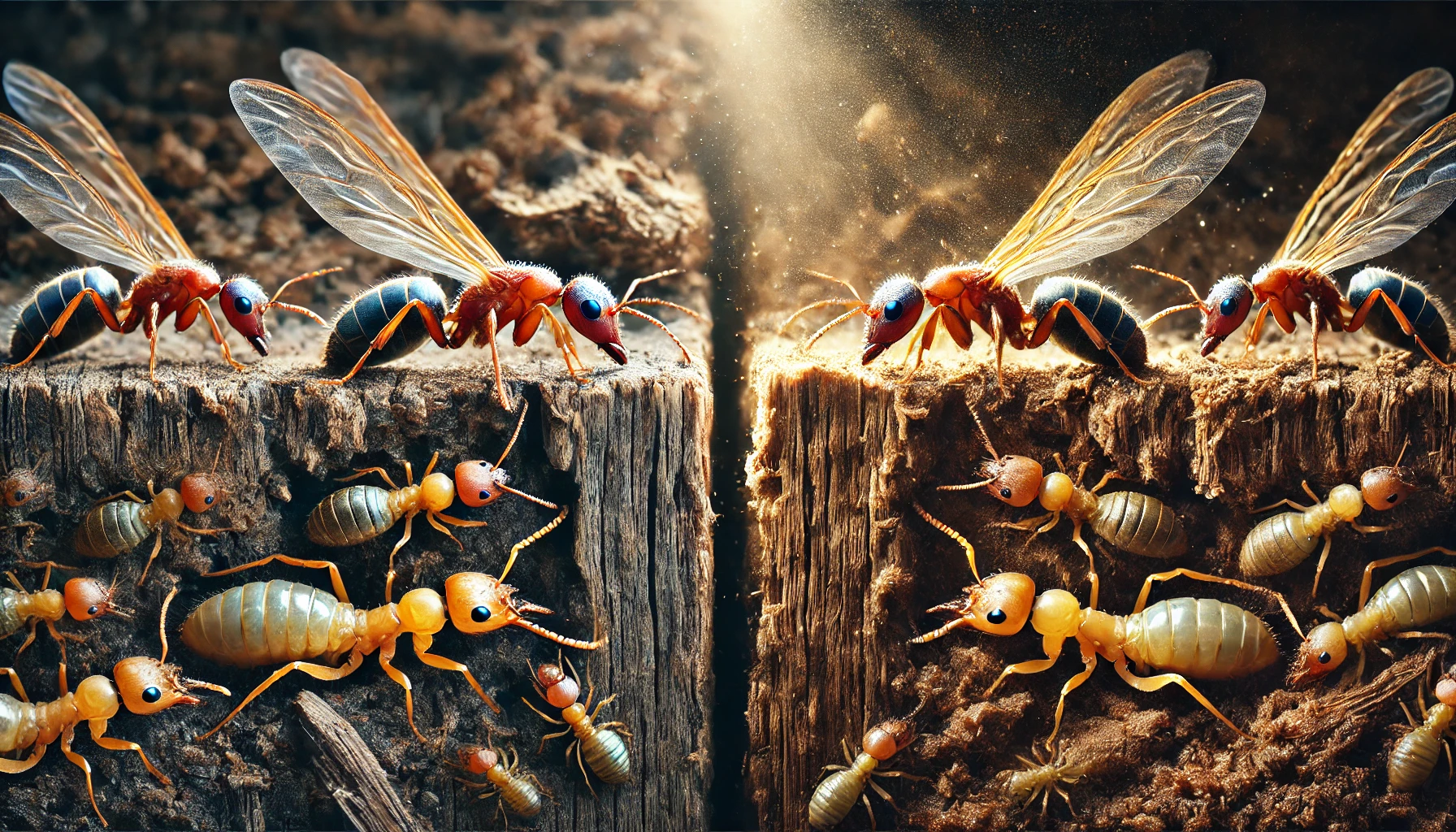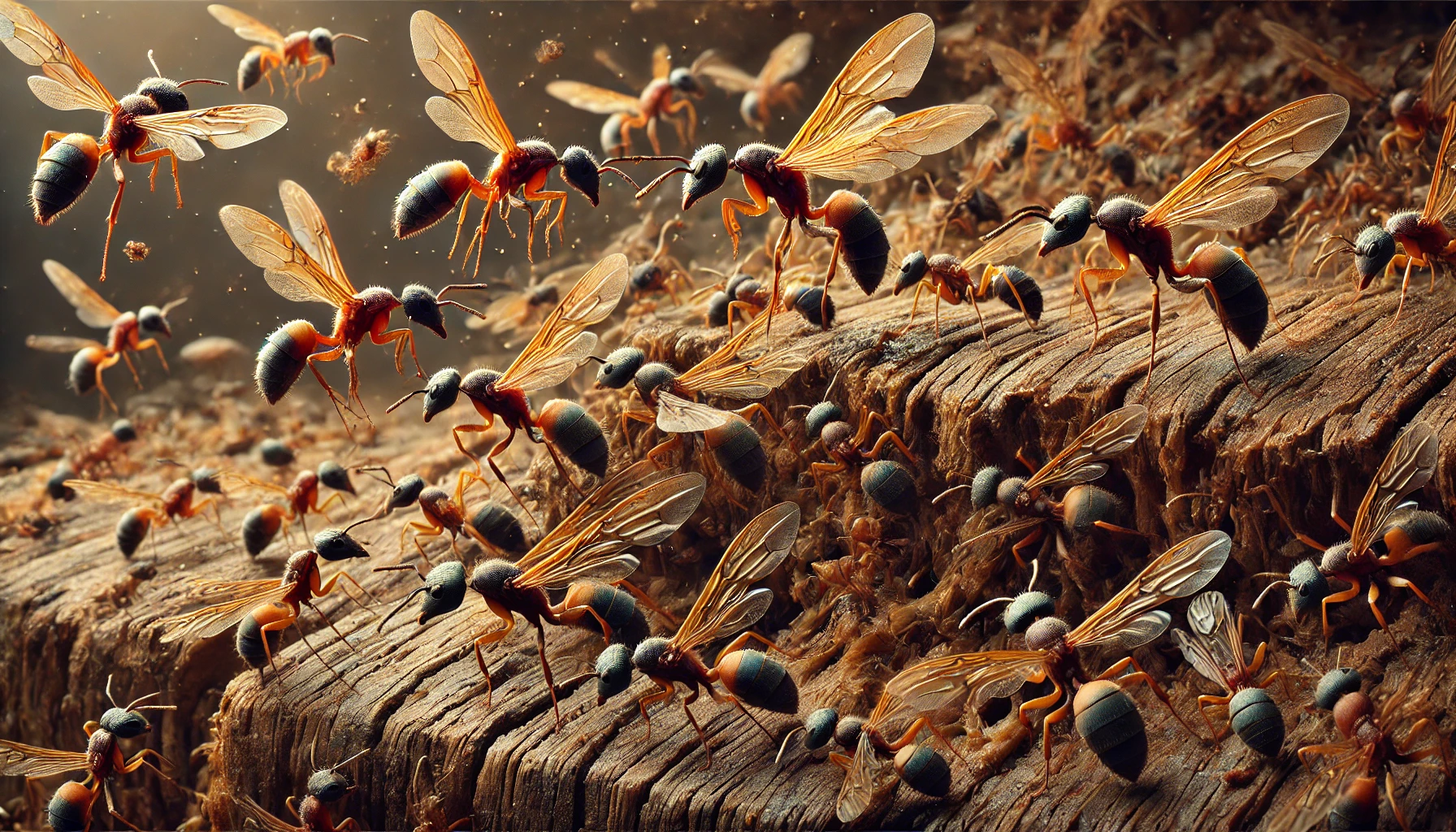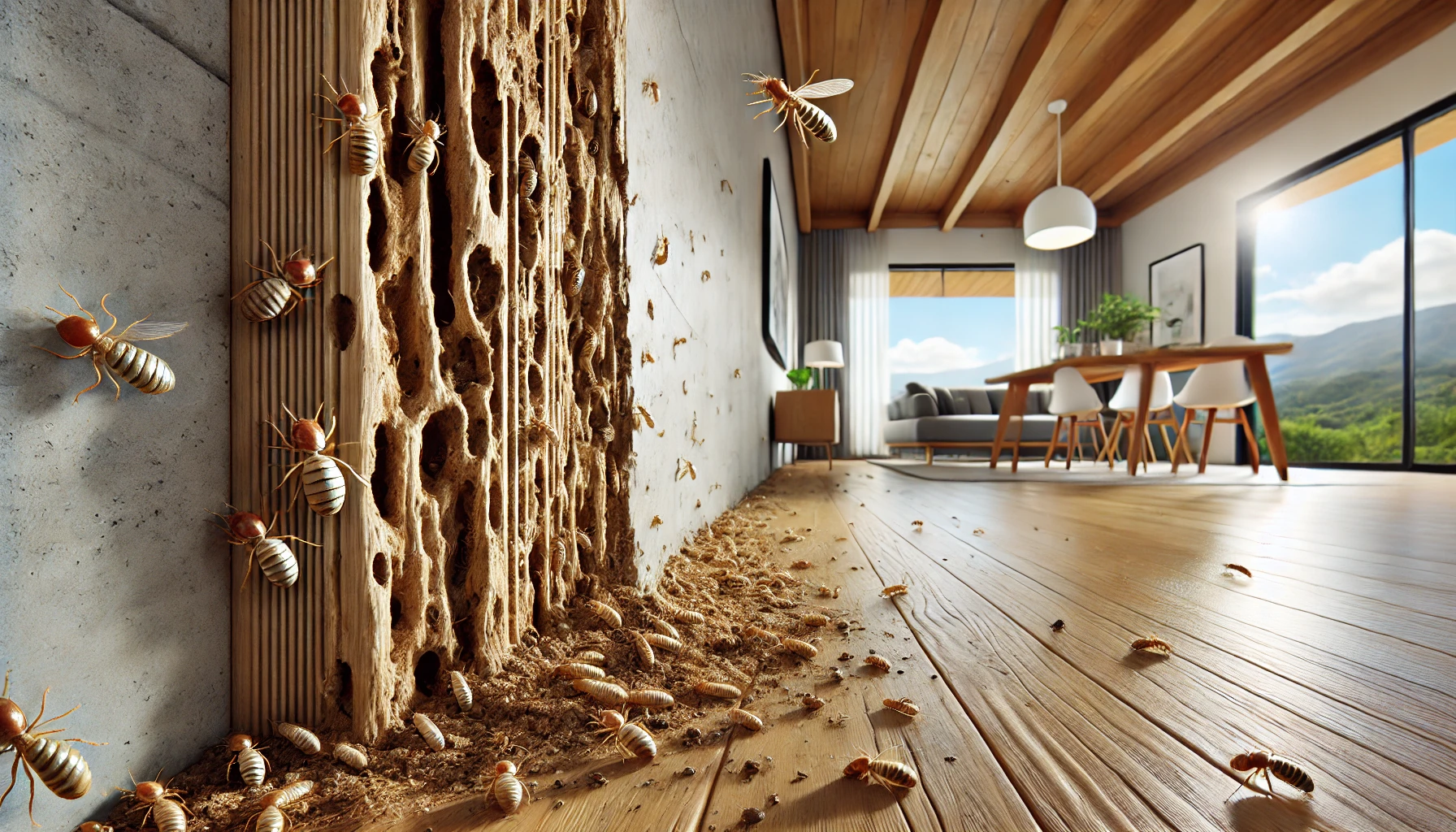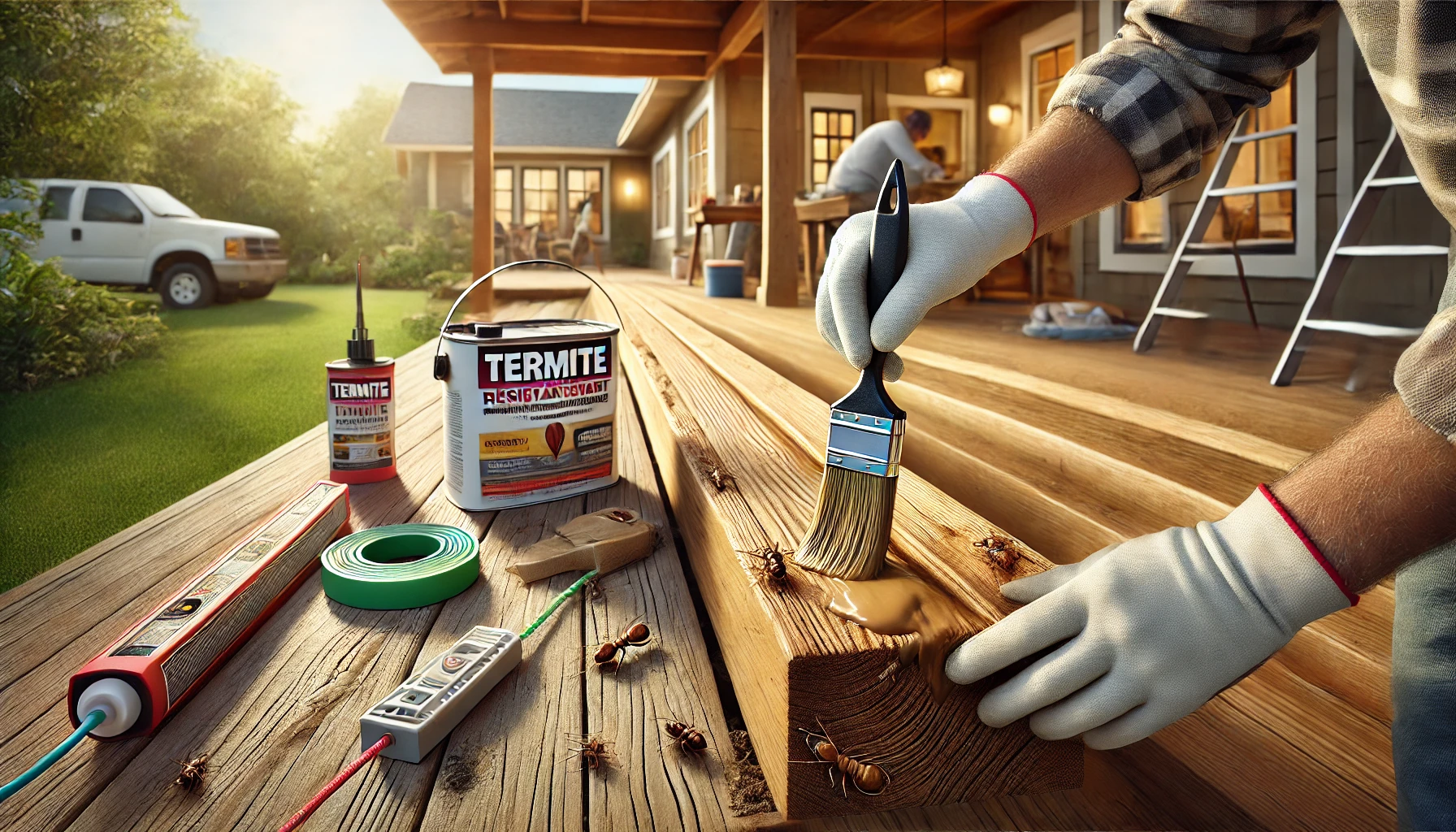Key Takeaways
- Winged ants and termites look similar but behave differently.
- Termites cause structural damage, while ants are mostly a nuisance.
- Termites have straight antennae and equal-sized wings.
- Ants have elbowed antennae and uneven wing sizes.
- Professional inspection is crucial for suspected termite infestations.
 If you’ve noticed swarms of flying insects in or around your home, you might wonder whether they’re winged ants or termites. While they look similar at first glance, knowing the difference is crucial because termites can cause severe structural damage to your home, while most ants are just a nuisance. This guide will help you identify, differentiate, and take the right action to protect your home from potential infestations.
If you’ve noticed swarms of flying insects in or around your home, you might wonder whether they’re winged ants or termites. While they look similar at first glance, knowing the difference is crucial because termites can cause severe structural damage to your home, while most ants are just a nuisance. This guide will help you identify, differentiate, and take the right action to protect your home from potential infestations.
Why Is It Important to Know the Difference?
Both flying ants and termites swarm during certain times of the year to mate and establish new colonies. However, while ants do not consume wood, termites do—making them far more destructive. A mistaken identification could lead to delayed treatment and increased property damage if termites go undetected.Key Differences Between Winged Ants and Termites
| Feature | Winged Ants | Termites |
|---|---|---|
| Body Shape | Narrow, pinched waist with distinct body segments | Thick, uniform waist with no noticeable segmentation |
| Antennae | Bent (elbowed) | Straight, bead-like |
| Wings | Two pairs, unequal in size (front wings longer than back wings) | Two pairs, equal in size, longer than the body |
Visual Identification
-
Waist Shape: Winged ants have a noticeably thin and pinched waist, while termites have a thicker, straight waist.
-
Antennae: Ants have antennae that bend at an angle, whereas termite antennae are straight and bead-like.
-
Wings: Termites have four equal-sized wings that extend beyond their body, whereas ants have two larger front wings and two smaller hind wings.
-
Wing Shedding: Termites shed their wings easily, leaving piles of wings near windows or doorways after swarming. Ants do not shed wings as quickly.


Not getting a solution?
Get your free pest control estimate today!Where and When Do They Appear?
Termite Swarmers
-
Typically appear in spring or early summer, especially after rain.
-
Found near wooden structures, foundations, or inside walls.
-
They tend to fly toward light sources at night.
-
Leave discarded wings around windowsills and doors.
-
A sign of a potentially severe infestation in your home’s structure.
Flying Ants
-
Swarm in late spring or summer, often on hot and humid days.
-
Found near entry points, such as windows or door cracks.
-
Usually come from an existing ant colony inside walls or outdoors.
-
Do not shed wings as readily as termites.
-
Presence is typically less destructive than termites, but some species, like carpenter ants, can damage wood.

Signs of a Termite Infestation
- If you suspect termites, look for these warning signs of infestation:
-
Mud Tubes: Subterranean termites create pencil-sized mud tunnels on foundations, walls, or crawl spaces.
-
Hollow-Sounding Wood: Termites eat wood from the inside out, leaving thin outer layers.
-
Soft or Damaged Wood: Warped floors, sagging ceilings, or peeling paint can indicate hidden termite activity.
-
Droppings (Frass): Drywood termites leave behind small, pellet-like droppings near infested areas.
-
Piles of Wings: If you find a pile of wings near windows or doors, it’s likely termite swarmers have emerged inside your home.
What to Do If You Have Winged Ants
- If you determine that the insects in your home are winged ants, follow these steps:
-
Eliminate Ant Trails: Use bait stations or insecticides to target the colony and disrupt their movement patterns.
-
Find and Seal Entry Points: Check around windows, doors, and baseboards for cracks or holes where ants may be entering your home.
-
Keep Food Sealed: Store sweets and food in airtight containers to prevent attracting ants and eliminating their food source.
-
Check for Carpenter Ants: If you suspect carpenter ants, look for sawdust piles or small holes in wood, as they can cause structural damage even though they don’t eat wood.
-
Monitor: If winged ants reappear, professional pest control may be needed to locate and remove the colony effectively.
What to Do If You Have Termites
- Termites require immediate action to prevent further damage. Here’s what to do:
-
Don’t Disturb the Colony: Avoid using over-the-counter sprays, as they may cause termites to spread further and make treatment more difficult.
-
Schedule a Professional Inspection: Contact a pest control expert for an in-depth inspection and a customized treatment plan to eliminate the infestation effectively.
-
Repair Damage: Once the infestation is eradicated completely, repair any wood damage to maintain your home’s safety and structural integrity.
-
Implement Prevention Measures: Regular inspections, moisture control, and sealing cracks can help prevent future termite problems and protect your home from reinfestation.
Consider Treatment Options
-
 Overview: Depending on the severity of the infestation, different treatment methods may be required to eliminate termites effectively.
Overview: Depending on the severity of the infestation, different treatment methods may be required to eliminate termites effectively. -
 Liquid Termiticides: Applied around the foundation to create a chemical barrier that prevents termites from entering and eliminates existing colonies.
Liquid Termiticides: Applied around the foundation to create a chemical barrier that prevents termites from entering and eliminates existing colonies. -
 Bait Stations: A slow-acting poison that termites bring back to their colony, gradually eliminating the entire infestation.
Bait Stations: A slow-acting poison that termites bring back to their colony, gradually eliminating the entire infestation. -
 Fumigation: Necessary for severe drywood termite infestations, as it penetrates deep into wood to eliminate hidden colonies.
Fumigation: Necessary for severe drywood termite infestations, as it penetrates deep into wood to eliminate hidden colonies.

Preventing Future Infestations
Tips to Prevent Ants
-
Keep your kitchens clean and tidy and store food in sealed tight containers.
-
Trim tree branches and plants touching your house.
-
Seal cracks around windows, doors, and foundations.
-
Use ant baits to prevent colonies from expanding.
Tips to Prevent Termites
-
 Eliminate Moisture: Fix leaky pipes, ensure proper drainage, and reduce humidity in crawl spaces to make your home less attractive to termites.
Eliminate Moisture: Fix leaky pipes, ensure proper drainage, and reduce humidity in crawl spaces to make your home less attractive to termites. -
 Keep Wood Away from Your Home: Store firewood at least 20 feet from the house to prevent termites from gaining easy access to your structure.
Keep Wood Away from Your Home: Store firewood at least 20 feet from the house to prevent termites from gaining easy access to your structure. -
 Use Termite-Resistant Materials: Opt for treated wood in construction projects to create a barrier against termite infestations.
Use Termite-Resistant Materials: Opt for treated wood in construction projects to create a barrier against termite infestations. -
 Get Annual Inspections: A professional termite inspection can catch problems early before significant damage occurs, ensuring long-term protection.
Get Annual Inspections: A professional termite inspection can catch problems early before significant damage occurs, ensuring long-term protection.






